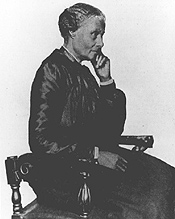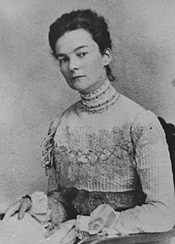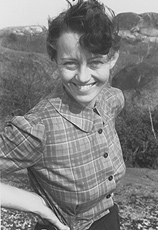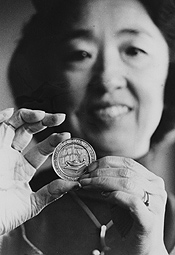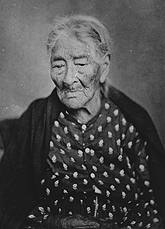Berkeleyan
Exploration, research, activism, and other women's work
New exhibit at Doe highlights the Bancroft Library's wealth of documentary resources - and its first century

31 March 2005
The Bancroft Library has mined its extensive collections on the history of California and the American West to prepare its new exhibit, "Our Collective Voice: The Extraordinary Work of Women in California." The exhibit, which also salutes the Bancroft's centennial, opens April 4 in the Doe Library's Bernice Layne Brown Gallery and runs through June 3.
The gallery's display cases are filled with journals, maps, oral-history transcripts, dance cards, photos, letters, manuscripts, posters, paintings, sketches, and life-size cutouts - all of which help tell the stories of women native or new to the state who made their marks as artists, explorers, scientists, activists, and philanthropists.
The productive lives of the women highlighted in the exhibit (five of
whom are depicted below) are sorted into various categories, including
Alta California, "Be-Mused" artists, "Cal Grrrls" (women students and
their mentors), advocates and activists (such as Dolores Huerta of the
United
Farm Workers), "Designing Women" (among them Julia Morgan and Catherine
Bauer Wurster), "Literary Lionesses" (such as Maxine Hong Kingston and
Gertrude Stein), and "Pioneering Women" (including Lillie Coit, Lola Montez,
and Lorena Lenity Hays, a Gold Rush-era newspaper columnist).
Doe Library is open 8 a.m. to 9 p.m. Monday through Thursday; 8 a.m. to 5 p.m. on Fridays; 9 a.m. to 5 p.m. on Saturdays, and 1 to 9 p.m. on Sundays. The Brown Gallery is located just inside the library's main entrance.
Mary Ellen Pleasant
Much of Pleasant's life is shrouded in mystery. She was said to have been born a slave in Georgia, and to have studied voodoo with Marie LaVeaux in New Orleans. In the 1840s she contributed to the success
of the Underground Railroad, and continued to support abolitionist causes for years to come. Resident in San Francisco both before and after the Civil War, passing as white for much of the time, she became a successful businesswoman, with a fortune estimated by some to be as much as $30 million. Her reputation as the "mother of civil rights in California" is due in part to her successful lawsuit against two San Francisco trolley companies that refused to transport blacks, a ruling that was ultimately upheld by the U.S. Supreme Court.
Annie Montague Alexander
An amateur naturalist, markswoman, and farmer, Alexander is best remembered at Berkeley as a paleontology enthusiast and a generous benefactor. She used the financial resources of her father, a Hawaiian sugar magnate, to underwrite various expeditions throughout North America and elsewhere. She and her partner, Louise Kellogg, conducted substantial fieldwork as well, retrieving specimens of disappearing flora and fauna. Alexander helped fund the campus Museum of Vertebrate Zoology (1908) and Museum of Paleontology (1934).
Catherine Bauer Wurster
Wurster is considered a founder of American housing policy; indeed, she is styled by one academic urban planner as "the Joan of Arc of the American housing movement." Her classic Modern Housing (1934) made her an authority on housing and a leading force behind passage of the U.S. Housing Act of 1937 - though the "sterile, uninspired" housing designs that followed its passage were a far cry from the communitarian, European-style projects she hoped to see developed in this country. A blend, as one scholar has written, of "equal parts Mae West and Margaret Mead, with a dash of Dorothy Parker and a pinch of Simone de Beauvoir," she had a long-running public affair with Lewis Mumford and was later married to William Wurster, who became dean of Berkeley's School of Architecture in 1950.
Yoshiko Uchida
hida and her family were suddenly sent to an internment camp. She kept a scrapbook of her experiences there, clipping newspaper stories about the graduation she missed and saving letters and cards. The Bancroft Library has the scrapbooks and numerous watercolors she painted to document internees' daily lives, first at the Tanforan Relocation Center in Belmont, and later at the Topaz Internment Camp in Utah. (Uchida and her sister worked as teachers in both locations.) Grade-school students in California still read her two books about her wartime experiences, Journey to Topaz (1971) and Journey Home (1978).
Eulalia Perez
Hubert Howe Bancroft conducted some 100 interviews with descendants of the original Californios, as the first wave of pre-statehood landowners, mostly of Mexican origin, are known. Of those interviews, only 12 were with women. Eulalia Perez's story recounts her life at Ranch San Isidro, near the San Gabriel Mission, where she worked as a manager, cook, and midwife before dying in 1878, at the age of 104. (Contemporary estimates of her age, which ranged as high as 140, were wisely discounted by Bancroft - and not only because they would, if somehow true, have meant that she gave birth to one daughter at the age of 79.)
|
![]()


